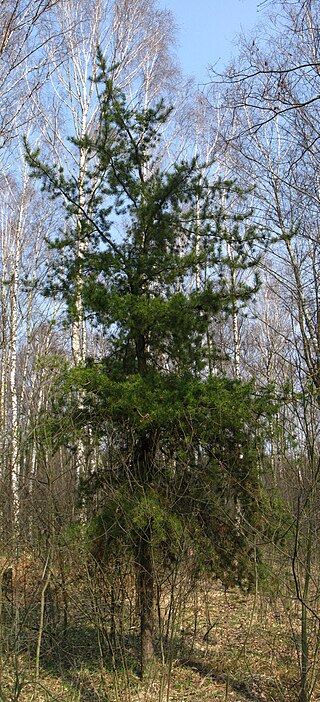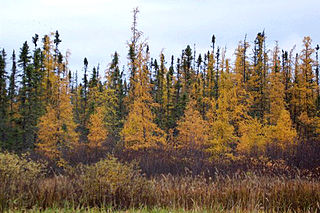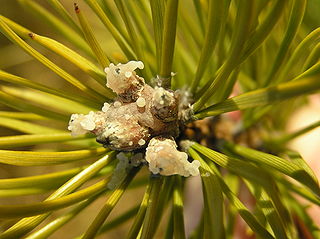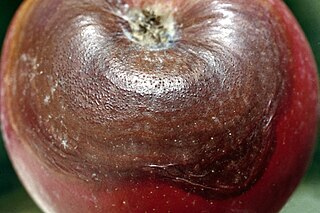
Pinus elliottii, commonly known as slash pine, is a conifer tree native to the Southeastern United States. Slash pine is named after the "slashes" – swampy ground overgrown with trees and bushes – that constitute its habitat. Other common names include swamp pine, yellow slash pine, and southern Florida pine. Slash pine has two different varieties: P. e. var. elliottii and P. e. var. densa. Historically, slash pine has been an important economic timber for naval stores, turpentine, and resin. The wood of slash pine is known for its unusually high strength, especially for a pine. It exceeds many hardwoods and is even comparable to very dense woods such as ironwood.

Jack pine, also known as grey pine or scrub pine, is a North American pine.

Pinus ponderosa, commonly known as the ponderosa pine, bull pine, blackjack pine, western yellow-pine, or filipinus pine is a very large pine tree species of variable habitat native to mountainous regions of western North America. It is the most widely distributed pine species in North America.

Larix laricina, commonly known as the tamarack, hackmatack, eastern larch, black larch, red larch, or American larch, is a species of larch native to Canada, from eastern Yukon and Inuvik, Northwest Territories east to Newfoundland, and also south into the upper northeastern United States from Minnesota to Cranesville Swamp, West Virginia; there is also an isolated population in central Alaska.

A plant canker is a small area of dead tissue, which grows slowly, often over years. Some cankers are of only minor consequence, but others are ultimately lethal and therefore can have major economic implications for agriculture and horticulture. Their causes include a wide range of organisms as fungi, bacteria, mycoplasmas and viruses. The majority of canker-causing organisms are bound to a unique host species or genus, but a few will attack other plants. Weather and animal damage can also cause stress to the plant resulting in cankers. Other causes of cankers is pruning when the bark is wet or using un-sterilized tools.

The blue spruce, also commonly known as green spruce, Colorado spruce, or Colorado blue spruce, is a species of spruce tree. It is native to North America, and is found in USDA growing zones 1 through 7. It is found naturally in Arizona, Colorado, Idaho, New Mexico, Utah and Wyoming. It has been widely introduced elsewhere and is used as an ornamental tree in many places far beyond its native range. It does well in zones warmer than 7 where summer heat is moderate, as at San Francisco. The blue spruce has blue-green colored needles and is a coniferous tree.

Cronartium ribicola is a species of rust fungus in the family Cronartiaceae that causes the disease white pine blister rust. Other names include: Rouille vésiculeuse du pin blanc (French), white pine Blasenrost (German), moho ampolla del pino blanco (Spanish).

Scleroderris canker, or Brunchorstia disease, Gremmeniella abietina, is a species of fungal diseases infecting coniferous forests. The main symptom is the death of the needles, leading to the death of the tree. In the forest industry, fighting off an infection of Scleroderris canker is usually not cost-effective. Clearing is often preferred over fungicidal methods, as the latter is harmful to other living organisms.

Diplodia tip blight, also known as Sphaeropsis blight, is a widespread disease affecting conifers caused by an opportunistic fungal pathogen, Diplodia sapinea. It is found in “both hemispheres between the latitudes 30° and 50° north and south". The diseases symptoms include: damping off and collar rot of seedlings, stem canker, root disease, and, most commonly, shoot blight. These symptoms have caused significant economic loss to nurseries and pine plantations. In a nursery in the north-central United States, losses of 35% have been reported. Shoot blight and eventual die back can cause a reduction of marketable volume in timber by 63%. Infection of terminal shoots can result in dead-top which significantly limits the usable length of the tree trunk. The presence of the pathogen in concert with severe weather conditions can lead to extreme loss. Following a severe hailstorm in South Africa, nearly 5,000 acres of pine plantation were infected with Diplodia tip blight. It was necessary to prematurely harvest large swaths of the plantations resulting in a loss of 45%. Areas that were not harvested prematurely still suffered an average timber loss of 11%.

Ophiognomonia clavigignenti-juglandacearum is a mitosporic fungus that causes the butternut canker, a lethal disease of butternut trees. It is also known to parasitize other members of the genus Juglans on occasion, and very rarely other related trees including hickories. The fungus is found throughout North America, occurring on up to 91% of butternut trees, and may be threatening the viability of butternut as a species.

Monilinia fructicola is a species of fungus in the order Helotiales. A plant pathogen, it is the causal agent of brown rot of stone fruits.
Brenneria is a genus of Pectobacteriaceae, containing mostly pathogens of woody plants. This genus is named after the microbiologist Don J. Brenner.

Botryosphaeria obtusa is a plant pathogen that causes frogeye leaf spot, black rot and cankers on many plant species. On the leaf it is referred to as frogeye leaf spot; this phase typically affects tree and shrubs. In fruit such as the apple, cranberry and quince, it is referred to as black rot, and in twigs and trunks it causes cankers.

Nectria cinnabarina, also known as coral spot, is a plant pathogen that causes cankers on broadleaf trees. This disease is polycyclic and infects trees in the cool temperate regions of the Northern Hemisphere. N. cinnabarina is typically saprophytic, but will act as a weak parasite if presented with an opportunity via wounds in the tree or other stressors that weaken the tree's defense to the disease. A study published in 2011 showed that this complex consists of at least 4 distinct species. There are only a few ways to manage this disease with techniques such as sanitation and pruning away branches that have the cankers. N. cinnabarina is not as significant a problem as other Nectria spp., some of which are the most important pathogens to infect hardwood trees.
The plant pathogenic fungus Leucostoma kunzei is the causal agent of Leucostoma canker, a disease of spruce trees found in the Northern Hemisphere, predominantly on Norway spruce and Colorado blue spruce. This disease is one of the most common and detrimental stem diseases of Picea species in the northeastern United States, yet it also affects other coniferous species. Rarely does it kill its host tree; however, the disease does disfigure by killing host branches and causing resin exudation from perennial lesions on branches or trunks.

Thousand cankers disease (TCD) is a recently recognized disease of certain walnuts. The disease results from the combined activity of the walnut twig beetle and a canker producing fungus, Geosmithia morbida. Until July 2010 the disease was only known to the western United States where over the past decade it has been involved in several large scale die-offs of walnut, particularly black walnut, Juglans nigra. However, in late July 2010 a well-established outbreak of the disease was found in the Knoxville, Tennessee, area. This new finding is the first locating it within the native range of its susceptible host, black walnut. In 2013, an outbreak was found in the Veneto region of Italy, where the disease has been found on both black walnut and English walnut.
Bleeding canker of horse chestnut is a common canker of horse chestnut trees that is known to be caused by infection with several different pathogens.

Fusarium circinatum is a fungal plant pathogen that causes the serious disease pitch canker on pine trees and Douglas firs. The most common hosts of the pathogen include slash pine, loblolly pine, Monterey pine, Mexican weeping pine, and Douglas fir. Like other Fusarium species in the phylum Ascomycota, it is the asexual reproductive state of the fungus and has a teleomorph, Gibberella circinata.

Hypoxylon canker of shade trees is a weak ascomycete fungus that negatively affects growth and can eventually lead to the death of already dying or diseased host trees. There are many different species that affect different trees. For example, Hypoxylon atropunctatum, a common species, is found on oak trees, Hypoxylon tinctor affects sycamore trees, and Hypoxylon mammatum infests aspen trees.

Cypress canker is a disease affecting Cupressus species, caused by one of several species of fungus in the genus Seiridium. Infection causes die-back of twigs and branches in susceptible cypress trees, with rapidly increasing amounts of damage and the death of the tree.
















